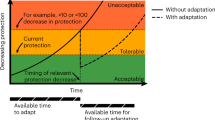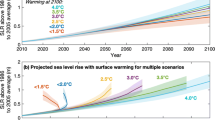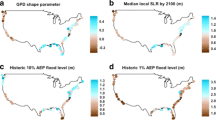Abstract
Strategies to manage the risks posed by future sea-level rise hinge on a sound characterization of the inherent uncertainties. One of the major uncertainties is the possible rapid disintegration of large fractions of the Antarctic ice sheet in response to rising global temperatures. This could potentially lead to several meters of sea-level rise during the next few centuries. Previous studies have typically been silent on two coupled questions: (i) What are probabilistic estimates of this “fast dynamic” contribution to sea-level rise? (ii) What are the implications for strategies to manage coastal flooding risks? Here, we present probabilistic hindcasts and projections of sea-level rise to 2100. The fast dynamic mechanism is approximated by a simple parameterization, designed to allow for a careful quantification of the uncertainty in its contribution to sea-level rise. We estimate that global temperature increases ranging from 1.9 to 3.1 °C coincide with fast Antarctic disintegration, and these contributions account for sea-level rise of 21–74 cm this century (5–95% range, Representative Concentration Pathway 8.5). We use a simple cost-benefit analysis of coastal defense to demonstrate in a didactic exercise how neglecting this mechanism and associated uncertainty can (i) lead to strategies which fall sizably short of protection targets and (ii) increase the expected net costs.






Similar content being viewed by others
References
Alley RB, Clark PU, Huybrechts P, Joughin I (2005) Ice-sheet and sea-level changes. Science 310:456–460. doi:10.1126/science.1114613
Bakker AMR, Applegate PJ, Keller K (2016) A simple, physically motivated model of sea-level contributions from the Greenland ice sheet in response to temperature changes. Environ Model Softw 83:27–35. doi:10.1016/j.envsoft.2016.05.003
Bakker AMR, Louchard D, Keller K (2017a) Sources and implications of the deep uncertainties surrounding sea-level projections. Clim Chang. doi:10.1007/s10584-016-1864-1
Bakker AMR, Wong TE, Ruckert KL, Keller K (2017b) Sea-level projections accounting for deeply uncertain ice-sheet contributions. Sci Rep. doi:10.1038/s41598-017-04134-5
Bamber JL, Aspinall WP (2013) An expert judgement assessment of future sea level rise from the ice sheets. Nat Clim Chang 3:424–427. doi:10.1038/nclimate1778
Bessette DL, Mayer LA, Cwik B et al (2017) Building a values-informed mental model for New Orleans climate risk management. Risk Anal. doi:10.1111/risa.12743
Cazenave A, Cozannet GL (2014) Sea level rise and its coastal impacts. Earth’s Futur 2:15–34. doi:10.1002/2013EF000188
Church JA, White NJ (2011) Sea-level rise from the late 19th to the early 21st century. Surv Geophys 32:585–602. doi:10.1007/s10712-011-9119-1
Church JA, Clark PU, Cazenave A, et al (2013) Sea level change. In: Climate Change 2013: the physical science basis. Contribution of Working Group I to the Fifth Assessment Report of the Intergovernmental Panel on Climate Change. Cambridge University Press, Cambridge
Coastal Protection and Restoration Authority of Louisiana (2017) Louisiana’s comprehensive master plan for a sustainable coast. Baton Rouge, LA
DeConto RM, Pollard D (2016) Contribution of Antarctica to past and future sea-level rise. Nature 531:591–597. doi:10.1038/nature17145
Diaz D, Keller K (2016) A potential disintegration of the West Antarctic ice sheet: implications for economic analyses of climate policy. Am Econ Rev 106:607–611. doi:10.1257/aer.p20161103
Dixon TH, Amelung F, Ferretti A et al (2006) Space geodesy: subsidence and flooding in New Orleans. Nature 441:587–588. doi:10.1038/441587a
Dyurgerov MB, Meier MF (2005) Glaciers and the changing earth system: a 2004 snapshot. Institute of Arctic and Alpine Research, University of Colorado Boulder
Gelman A, Rubin DB (1992) Inference from iterative simulation using multiple sequences. Stat Sci 7:457–511. doi:10.1214/ss/1177011136
Gouretski V, Koltermann KP (2007) How much is the ocean really warming? Geophys Res Lett. doi:10.1029/2006GL027834
Grinsted A, Moore JC, Jevrejeva S (2010) Reconstructing sea level from paleo and projected temperatures 200 to 2100 AD. Clim Dyn 34:461–472. doi:10.1007/s00382-008-0507-2
Hinkel J, Jaeger C, Nicholls RJ et al (2015) Sea-level rise scenarios and coastal risk management. Nat Clim Chang 5:188–190. doi:10.1038/nclimate2505
Jackson LP, Jevrejeva S (2016) A probabilistic approach to 21st century regional sea-level projections using RCP and high-end scenarios. Glob Planet Change 146:179–189. doi:10.1016/j.gloplacha.2016.10.006
Jevrejeva S, Grinsted A, Moore JC (2014) Upper limit for sea level projections by 2100. Environ Res Lett 9:104008. doi:10.1088/1748-9326/9/10/104008
Jones CE, An K, Blom RG et al (2016) Anthropogenic and geologic influences on subsidence in the vicinity of New Orleans, Louisiana. J Geophys Res Solid Earth. doi:10.1002/2015JB012636
Jonkman SN, Kok M, Van Ledden M, Vrijling JK (2009) Risk-based design of flood defence systems: a preliminary analysis of the optimal protection level for the New Orleans metropolitan area. Flood Risk Manag 2:170–181. doi:10.1111/j.1753-318X.2009.01036.x
Joughin I, Smith BE, Medley B (2014) Marine ice sheet collapse potentially under way for the Thwaites Glacier Basin, West Antarctica. Science 735–739
Kopp RE, Horton RM, Little CM et al (2014) Probabilistic 21st and 22nd century sea-level projections at a global network of tide-gauge sites. Earth’s Futur 2:383–406. doi:10.1002/2014EF000239
Kopp RE, Kemp AC, Bittermann K et al (2016) Temperature-driven global sea-level variability in the common era. Proc Natl Acad Sci United States Am 113:E1434–E1441. doi:10.1073/pnas.1517056113
Kopp R, DeConto RM, Bader D, et al (2017) Implications of ice-shelf hydrofracturing and ice cliff collapse mechanisms for sea-level projections. Preprint at arXiv:1704.05597
Kriegler E (2005) Imprecise probability analysis for integrated assessment of climate change. Universität Potsdam, Potsdam
Le Bars D, Drijfhout S, de Vries H (2017) A high-end sea level rise probabilistic projection including rapid Antarctic ice sheet mass loss. Environ Res Lett 39:51230. doi:10.1088/1748-9326/aa6512
Little CM, Urban NM, Oppenheimer M (2013) Probabilistic framework for assessing the ice sheet contribution to sea level change. Proc Natl Acad Sci United States Am 110:3264–3269. doi:10.1073/pnas.1214457110
Meinshausen M, Smith SJ, Calvin K et al (2011) The RCP greenhouse gas concentrations and their extensions from 1765 to 2300. Clim Chang 109:213–241. doi:10.1007/s10584-011-0156-z
Mengel M, Levermann A, Frieler K et al (2016) Future sea level rise constrained by observations and long-term commitment. Proc Natl Acad Sci United States Am 113:2597–2602. doi:10.1073/pnas.1500515113
Morice CP, Kennedy JJ, Rayner NA, Jones PD (2012) Quantifying uncertainties in global and regional temperature change using an ensemble of observational estimates: the HadCRUT4 data set. J Geophys Res Atmos. doi:10.1029/2011JD017187
Moritz H, White K, Gouldby B et al (2015) USACE adaptation approach for future coastal climate conditions. Proc Inst Civ Eng Marit Eng 168:111–117. doi:10.1680/jmaen.15.00015
Nicholls RJ, Cazenave A (2010) Sea level rise and its impact on coastal zones. Science 328:1517–1520. doi:10.1126/science.1185782
Oppenheimer M, Alley RB (2016) How high will the seas rise? Science 354:1375–1377. doi:10.1126/science.aak9460
Oppenheimer M, Little CM, Cooke RM (2016) Expert judgement and uncertainty quantification for climate change. Nat Clim Chang 6:445–451. doi:10.1038/nclimate2959
Pfeffer WT, Harper JT, O’Neel S (2008) Kinematic constraints on glacier contributions to 21st-century sea-level rise. Science 321:1340–1343. doi:10.1126/science.1159099
Pollard D, DeConto RM (2009) Modelling West Antarctic ice sheet growth and collapse through the past five million years. Nature 458:329–332. doi:10.1038/nature07809
Pollard D, DeConto RM, Alley RB (2015) Potential Antarctic ice sheet retreat driven by hydrofracturing and ice cliff failure. Earth Planet Sci Lett 412:112–121. doi:10.1016/j.epsl.2014.12.035
Rhodes CJ (2016) The 2015 Paris climate change conference: COP21. Sci Prog 99:97–104. doi:10.3184/003685016X14528569315192
Ritz C, Edwards TL, Durand G et al (2015) Potential sea-level rise from Antarctic ice-sheet instability constrained by observations. Nature 528:115–118. doi:10.1038/nature16147
Ruckert KL, Shaffer G, Pollard D et al (2017) Assessing the impact of retreat mechanisms in a simple Antarctic ice sheet model using Bayesian calibration. PLoS One 12:e0170052. doi:10.1371/journal.pone.0170052
Sasgen I, Van den Broeke M, Bamber JL et al (2012) Timing and origin of recent regional ice-mass loss in Greenland. Earth Planet Sci Lett 333:293–303. doi:10.1016/j.epsl.2012.03.033
Shaffer G (2014) Formulation, calibration and validation of the DAIS model (version 1), a simple Antarctic ice sheet model sensitive to variations of sea level and ocean subsurface temperature. Geosci Model Dev 7:1803–1818. doi:10.5194/gmd-7-1803-2014
Slangen ABA, Carson M, Katsman CA et al (2014) Projecting twenty-first century regional sea-level changes. Clim Chang 124:317–332. doi:10.1007/s10584-014-1080-9
Urban NM, Keller K (2010) Probabilistic hindcasts and projections of the coupled climate, carbon cycle and Atlantic meridional overturning circulation system: a Bayesian fusion of century-scale observations with a simple model. Tellus A 62:737–750. doi:10.1111/j.1600-0870.2010.00471.x
Urban NM, Holden PB, Edwards NR et al (2014) Historical and future learning about climate sensitivity. Geophys Res Lett 41:2543–2552. doi:10.1002/2014GL059484
Van Dantzig D (1956) Economic decision problems for flood prevention. Econometrica 24:276–287. doi:10.2307/1911632
Vihola M (2012) Robust adaptive metropolis algorithm with coerced acceptance rate. Stat Comput 22:997–1008. doi:10.1007/s11222-011-9269-5
Wigley TML, Raper SCB (2005) Extended scenarios for glacier melt due to anthropogenic forcing. Geophys Res Lett. doi:10.1029/2004GL021238
Wong TE, Bakker AMR, Ruckert KL et al (2017) BRICK0.2, a simple, accessible and transparent model framework for climate and sea-level projections. Geosci Model Dev 10:2741–2760. doi:10.5194/gmd-10-2741-2017
Acknowledgements
We thank Dave Pollard for lending his insight into reasonable prior ranges and central values for the Antarctic ice sheet fast dynamic parameters and for comments on the initial version of the manuscript. We thank Kelsey Ruckert and Yawen Guan for their assistance in providing and interpreting codes relevant to the original DAIS model and its calibration. We also thank Kelsey Ruckert for manuscript formatting assistance. We thank Aimée Slangen for supplying and assistance interpreting the regional sea-level fingerprinting data. We gratefully acknowledge Richard Alley, Murali Haran, Chris and Bella Forest, Rob Nicholas, Patrick Reed, Michael Oppenheimer, Tad Pfeffer, Rob Lempert, David Johnson, Roger Cooke, and Dale Jennings for invaluable inputs. This work was partially supported by the National Science Foundation through the Network for Sustainable Climate Risk Management (SCRiM) under NSF cooperative agreement GEO-1240507 as well as the Penn State Center for Climate Risk Management. Any conclusions or recommendations expressed in this material are those of the authors and do not necessarily reflect the views of the funding agencies. Any errors and opinions are, of course, those of the authors.
Code availability
The BRICK model (with the added fast dynamic module) and analysis codes are freely available from https://github.com/scrim-network/BRICK/tree/fastdy. Large parameter files and model results files are available from https://download.scrim.psu.edu/Wong_etal_BRICK. Code examples and a routine for fingerprinting sea-level rise projections to other locations (aside from New Orleans, as presented in this manuscript) are provided at https://github.com/scrim-network/BRICK. The physical models are coded in Fortran 90 and called from driver scripts coded in the R Programming Language. The analysis was performed using RStudio (version 0.99.903).
Author information
Authors and Affiliations
Contributions
T.W. and K.K. initiated the study. T.W., A.B., and K.K. designed the research. T.W. and A.B. produced the model simulations. T.W. designed the initial figures and wrote the first draft. All contributed to the final text.
Corresponding author
Electronic supplementary material
Online Resource 1
(ESM_1.pdf) Supplementary figures are provided, with captions. (PDF 694 kb)
Online Resource 2
(ESM_2.pdf) Page 1 table contains the following: parameter names (column 1); model of origin (column 2); ensemble median, 5% quantile, and 95% quantile (columns 3, 4, and 5), from the experiment using the gamma priors for the fast dynamics; prior range lower and upper bounds, when assigned uniform priors (columns 6 and 7); and units (column 8). Page 2 table contains the following: parameter names (column 1), model of origin (column 2), and brief description (column 3). (PDF 26 kb)
Rights and permissions
About this article
Cite this article
Wong, T.E., Bakker, A.M.R. & Keller, K. Impacts of Antarctic fast dynamics on sea-level projections and coastal flood defense. Climatic Change 144, 347–364 (2017). https://doi.org/10.1007/s10584-017-2039-4
Received:
Accepted:
Published:
Issue Date:
DOI: https://doi.org/10.1007/s10584-017-2039-4




